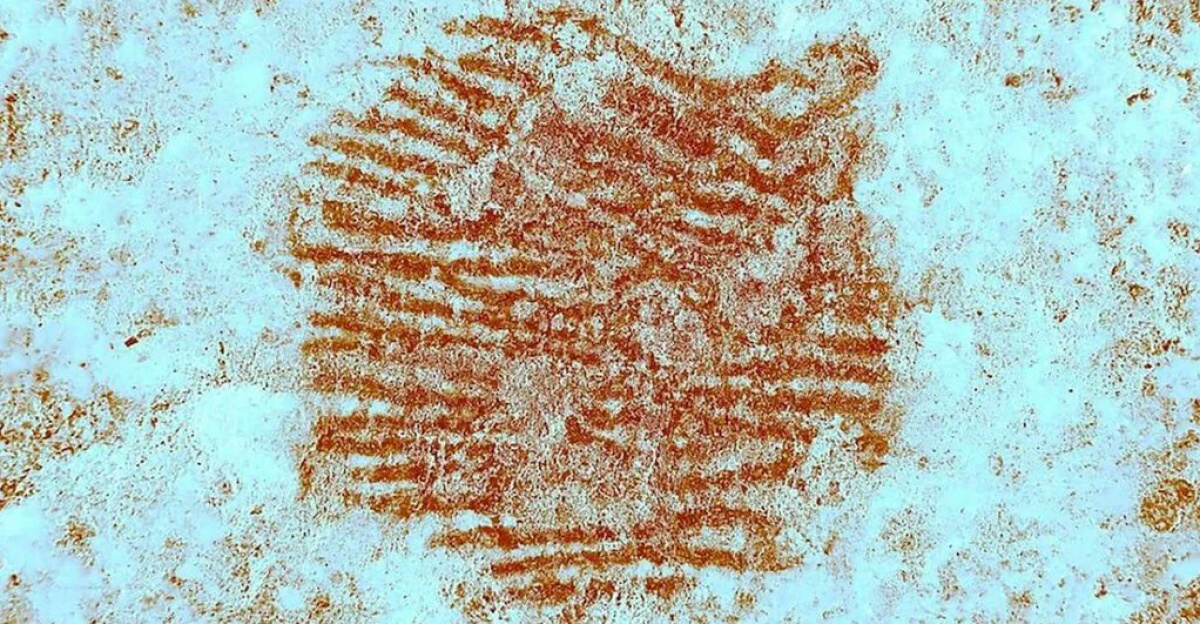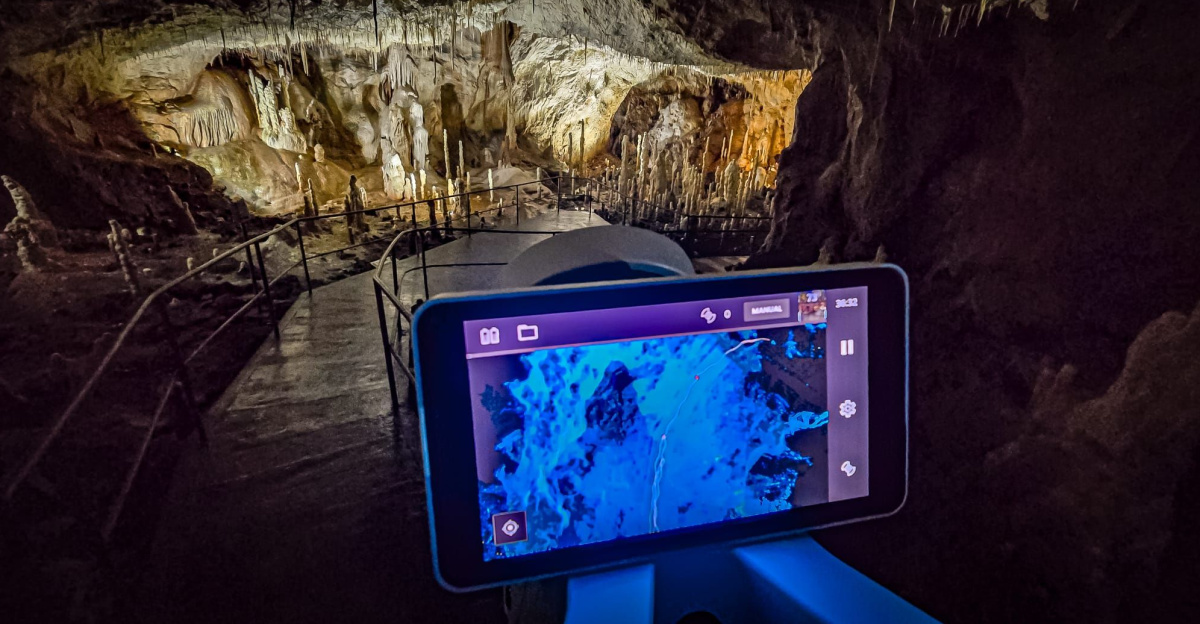
Researchers reported in 2025 that they had discovered what is now thought to be the oldest complete human fingerprint in the world. It was discovered on a small granite pebble that was stained red ochre at the San Lázaro rock shelter near Segovia, Spain, and dates to around 43,000 years ago. Because the Iberian Peninsula is a crucial area for comprehending the cultural and cognitive distinctions between Neanderthals and Homo sapiens during the Late Pleistocene, this context is essential.
Instead of being discovered on a tool or other commonplace item, the fingerprint was discovered embedded in pigment, indicating that it was a part of a deliberate act that may have been artistic or symbolic in nature.
Historical Background and Neanderthal Skills

For a large portion of the previous century, it was widely believed that Neanderthals lacked the cultural complexity and symbolic thinking of their modern-day Homo sapiens counterparts. Nonetheless, the discovery of this fingerprint, which dates to approximately 43,000 years ago, corresponds to the latter phases of Neanderthal life before their ultimate extinction some 40,000 years ago.
These hints imply that Neanderthals possessed the mental capacity to create abstract images and use art as a social medium. The deliberateness and planning that went into moving the pebble from its riverbed origin into the shelter instead of leaving it where it was discovered is evident. This strengthens the case that Neanderthals were culturally advanced in ways that have only lately been recognized, rather than cognitively inferior.
The Fingerprint’s Artistry: Face Pareidolia and Symbolism

The natural pattern of three depressions on the San Lázaro pebble’s surface, which resemble basic facial features—two “eye” cupules and a concave “mouth”, is among its most striking features. These characteristics, together with the fingerprint’s carefully positioned red ochre dot, strongly imply that Neanderthals used natural rock formations to elicit face pareidolia, the phenomenon in which people automatically see faces in abstract shapes.
The interpretation of intentional targeting is supported by statistical analysis, which indicates that there is only a 0.31% chance that the red dot’s placement happened by chance. If verified as deliberate symbolism, this finding calls into question the long-held belief that the creation of symbolic art was a distinctive characteristic of humans.
Scientific and Forensic Advancements in Identification

Only state-of-the-art forensic techniques, which have historically been employed in criminal investigations, could detect and analyze the fingerprint embedded within the ochre pigment, which was invisible to the naked eye. To improve the fingerprint’s ridge patterns, the interdisciplinary research team modified forensic dermatoglyphics and multispectral imaging, which gathers information across light wavelengths that are invisible to the human eye.
By providing fresh approaches to find prehistoric human traces that would otherwise go unnoticed, this methodology broadens the purview of archaeological detective work. It offers intriguing possibilities for reexamining additional pigment-stained artifacts from archaeological sites around the world, possibly revealing a more extensive record of early human interaction and symbolic behavior.
Putting Conventional Wisdom to the Test

Despite the excitement surrounding the discovery, some experts advise against making too many assumptions. Skeptics contend that imposing contemporary ideas of art and symbolism onto vague prehistoric markings carries a risk. To illustrate the difficulty of conclusively proving intentional symbolism in deep prehistory, anthropologist Bruce Hardy, for instance, acknowledges the intentional application of ochre but cautions against reading the pebble as a face or meaningful representation.
However, the obvious existence of a human fingerprint along with the intentional application of pigment suggests intentional action as opposed to randomness. This argument highlights the need for strict criteria in determining symbolic meaning and is reminiscent of similar disputes surrounding early cave paintings and engraved artifacts.
Implications for Psychology and Evolution

Psychologically, early human ideas of identity, social connection, and self-awareness are linked to the capacity to leave a fingerprint by combining pigment and marking a familiar “face” on an object. This kind of symbolic behavior is fundamental to ritual practice, language development, and cultural transmission.
Planning and foresight are further demonstrated by the pebble’s deliberate transportation to the shelter for marking. By focusing on convergence rather than exclusivity in cognitive evolution, this changes the timeline for the emergence of symbolic thought and rewrites the story of human uniqueness from an evolutionary perspective.
Broader Trends in Archaeology and Technological Collaborations

As evidenced by decorated caves in Gibraltar and Iberia, personal ornaments like eagle talon necklaces, and the widespread use of ochre pigments across sites contemporaneous to early Homo sapiens, the fingerprint discovery adds to the growing body of evidence demonstrating Neanderthals’ symbolic activities. Older notions of cultural inferiority are refuted by this increasing awareness of Neanderthal symbolic behavior.
By combining analytical tools from digital imaging, forensics, and medicine, archaeological techniques are extended beyond excavation and anthropological interpretation to reveal subtle or invisible features. This multidisciplinary method may transform our understanding of prehistoric human behavior worldwide and establish new benchmarks for thorough artifact analysis.
Untested Theories and Prospective Research Paths

Provocative new theories regarding early human behavior are brought up by this fingerprint. Could these markings be a type of proto-signature or identity marking in which people “signed” objects to indicate their ownership, presence, or social position? Long before formal scripts evolved, this signified a conceptual leap into proto-writing or symbolic communication.
Networks of symbolic interaction and culturally significant artifacts among Neanderthals may be discovered through future excavations or reanalysis of collections. These results have the potential to significantly change theories of cognitive abilities, social complexity, and cultural transmission. Multidisciplinary cooperation to test these theories may lead to the development of new areas at the nexus of semiotics, psychology, and archaeology.
Anthropological and Sociocultural Revisions to Narrative

An anthropological narrative from the 20th century that suggested a pronounced cognitive difference between Neanderthals and modern humans is effectively refuted by this fingerprint discovery. It is now indisputable that Neanderthals behaved symbolically, created art, and thought abstractly, calling for a redefinition of what it means to be “human.”
These changing viewpoints have an impact on larger social discussions concerning shared ancestry, identity, and human origins. Respect and interest in our extinct cousins are fostered when Neanderthals are acknowledged as belonging to the symbolic cultural lineage. This enhances the story of the origins of creativity.
A Novel View of the Evolution of Human Cognitive Ability

Not only is the 43,000-year-old fingerprint that was found to belong to a Neanderthal person a remarkable archaeological find, but it also provides important new information about how human cognition and symbolic behavior have evolved. By uncovering hidden evidence of prehistoric artistry, the use of forensic science to identify and validate this mark on an ochre-stained pebble demonstrates how new technologies have the power to rewrite history.
It calls for a reinterpretation of “humanity” that includes our extinct ancestors as cultural contributors rather than merely biological oddities. This fresh viewpoint opens the door for multidisciplinary studies that combine anthropology, psychology, forensic science, and archaeology to better understand the evolution of cognition.






